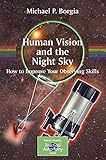Human Vision and the Night Sky : Hot to Improve Your Observing Skills / by Michael P. Borgia.
Tipo de material: TextoSeries Patrick Moore’s Practical Astronomy SeriesEditor: New York, NY : Springer New York, 2006Descripción: xI, 291 páginas, recurso en líneaTipo de contenido:
TextoSeries Patrick Moore’s Practical Astronomy SeriesEditor: New York, NY : Springer New York, 2006Descripción: xI, 291 páginas, recurso en líneaTipo de contenido: - texto
- computadora
- recurso en línea
- 9780387463223
- QB4
Springer eBooks
The Integrated Observing System. Part I:Your Eyes -- The Integrated Observing System. Part II:Your Equipment -- Putting the Integrated Observing System Together -- First Night Out -- Mysteries of the Moon -- Secrets of the Sun -- Mercury, Venus, and the Inner Solar System -- The Enigmas of Mars, the Red Planet -- Comets and Asteroids, the Cosmic Leftovers of Creation -- Jupiter and Saturn, Kings of Worlds -- The Outer Worlds; Uranus, Neptune, Pluto, and Beyond -- Twinkle, Twinkle Little Star (Now Knock It Off!) -- Faint, Fuzzy Things. Part I:P henomena Galactica -- Faint, Fuzzy Things. Part II:The Island Universes.
This book is not for beginners. Nor is it for experts – instead it addresses the needs of practical amateur astronomers who want to make the jump to the new challenges of serious visual observing. Second Steps in Observational Astronomy begins by teaching you, as an amateur astronomer, to use the most important tool you have: your eyes. Visual observing is very definitely a skill that can be learned. Of course it is important to have your other optical equipment – telescope and accessories – set up and operating as perfectly as possible. This book describes how. After these vital preliminaries, subsequent chapters include a series of observing challenges that will entertain you and push your observing skills to continually higher levels of excellence for years to come. Take a tour of the solar-system as you never viewed it before, then beyond into the realm of deep space – using just your own eyes to reveal more detail than you ever thought possible.
Para consulta fuera de la UANL se requiere clave de acceso remoto.


